Last Updated 09/10/2021
Accompanied by "The last Post" (Tattoo)
Destined to fight World War II from beginning to end, the light cruiser ST. LOUIS slid down the Ways of the Newport News Shipbuilding and Dry Dock Company of Newport News, Virginia, on 15 April 1938. She was built under the limitation of the London Naval Treaty of 1930 and was one of a class of two, the ST. LOUIS class of 1935, with the ill-fated USS HELENA (CL 50) her sister ship.
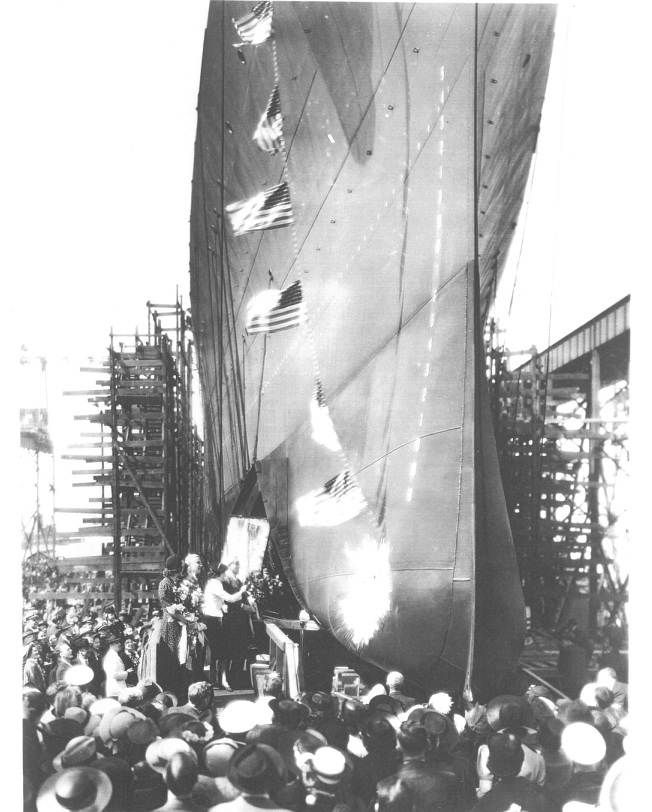
The traditional champagne bottle was smashed on her bow by Miss Nancy Lee Morrill of the city of St. Louis, chosen for this honor by Governor Lloyd Stark of Missouri, a 1908 graduate of the Naval Academy. Commissioning Day was 19 May, 1939 with Captain C. H. Morrison USN, also of the city of St. Louis, reading his orders to the crew at the Norfolk Virginia Navy Yard. The "Lucky Lou", as the ship was to be affectionately called, was the fifth United States ship to be named in honor of the city.
.jpg)
The first, an 18-gun sloop-of-war of 700 tons, built in 1827 -28, cruised West Indian waters to suppress piracy. Later she served in the Pacific and in the Mediterranean and, during the Civil War, participated in the blockade of the Gulf and South Atlantic ports. Her last duty was as a training ship and in 1907 she vas sold.
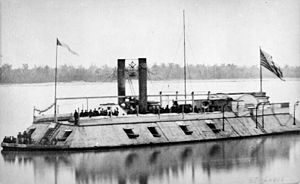
The second St. LOUIS was a river steamboat built in 1861, the first ironclad ship in the United States service. Operated by the Army with the flotillas attacking the Mississippi River forts, she too saw service in the Civil War. In 1862 she was taken over by the Navy and renamed BARON DEKALB. The ship was sunk by a floating mine in July 1863, at a point below Yazoo City, Mississippi.
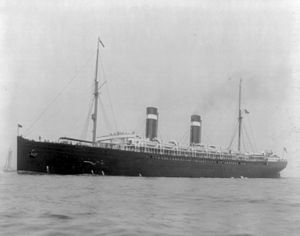
The third St. LOUIS was one of the first two American-built ocean liners built prior to the Spanish-American War. Construction was carried out under the supervision of the Navy Department for use as an auxiliary cruiser in time of war. She was commissioned by the Navy at the outbreak of hostilities with Spain and used for transporting troops to Cuba and Puerto Rico. She also took part in the blockade of Spanish ports and, after the defeat of the Spanish squadron at Santiago, Cuba, she transported the Spanish Admiral Cervera and 700 of his men to the United States, During World War I she was used as a transport under the name LOUISVILLE, as the fourth St. LOUIS was then in commission.
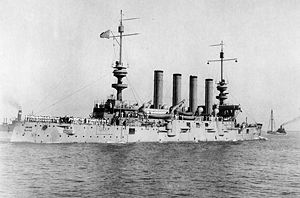
The fourth ST. LOUIS was a cruiser of 9,707 tons, commissioned in 1906. At the time of our entry into World War I she was stationed in the Pacific end before we went to war, frustrated an attempt to sabotage shipping and wharves of Honolulu by the officers of the interned German gunboat GEIER.
She was assigned to the Cruiser and Transport Force in 1917 with which she convoyed and transported troops to France. After the Armistice she returned to European waters and operated in the Mediterranean. Decommissioned in 1922, she was sold in 1930.
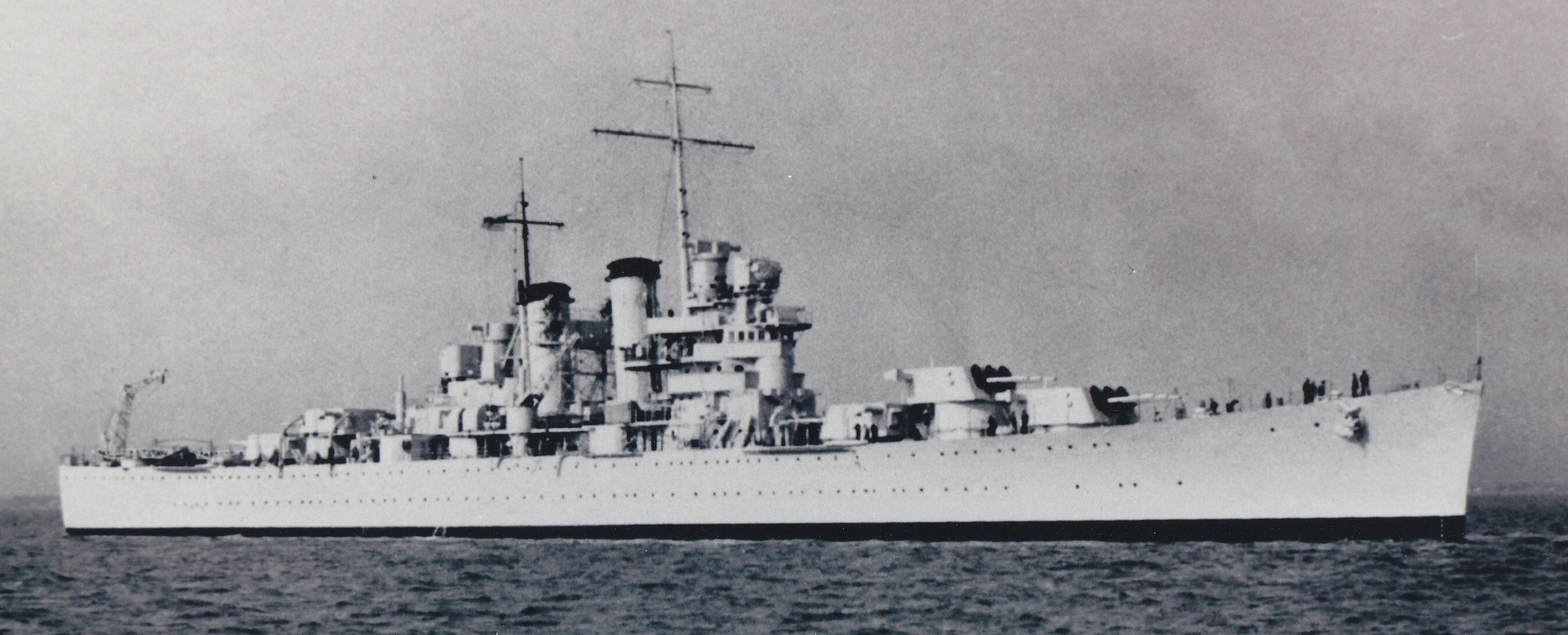
The fifth USS St. LOUIS was occupied with fitting out, shakedown cruise, training and post shakedown overhaul until 21 December 1939. Her shakedown cruise, out of Norfolk, included Guantanamo Bay, Cuba; Kingston, Jamaica; Port of Spain, Trinidad; Ponta Delgada, Azores; and New York City.
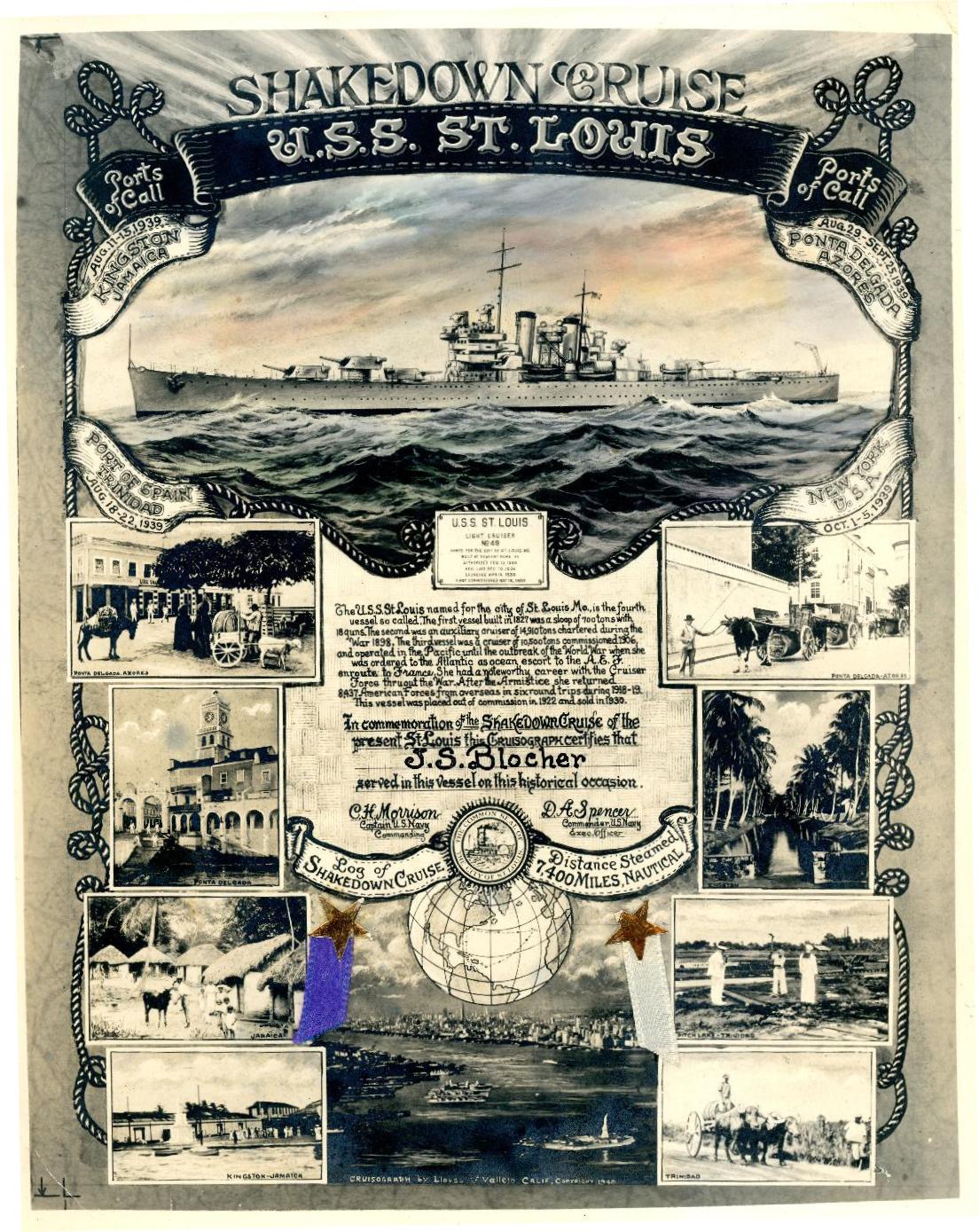
[ Our thanks to Suzanne Day, niece of Shipmate and Plankowner Joseph Samuel Blocher, Jr.-S1/c, USN-Aboard 19 May 1939 to 12 Apr 1940-, for kindly sharing this certificate ]
Upon completion, the ship was assigned to the Atlantic Neutrality Patrol, where she remained until 3 September 1940, she conducted extensive training exercises in gunnery and tactics.
On 3 September, with talk of the British "Destroyer Bases" in the air, St. LOUIS carried a board of experts on a tour of selection upon which the sites most suitable for American naval and air bases were selected. This trip included Bermuda, Newfoundland the Bahamas, Jamaica, Trinidad, British. Guiana, St.-Lucia and Antigua.
She returned to the United States on 27 October 1940 and on 9 November was underway to make her first appearance in the Pacific, via Guantanamo and the Panama Canal. On 27 May 1941, Captain Morrison was relieved by Captain G. A, Rood, USN.
With the war clouds gathering fast St. LOUIS convoyed the Army transport USAT Henderson to Manila by way of the outpost islands of Wake, Midway, and Guam. At the time security rules were beginning to tighten and all hands were instructed not to divulge the identity of ST. LOUIS, then at anchor off of Manila. Resultant conjecture gave rise to the ship's new nickname, "The Mystery Ship of the United States Fleet."
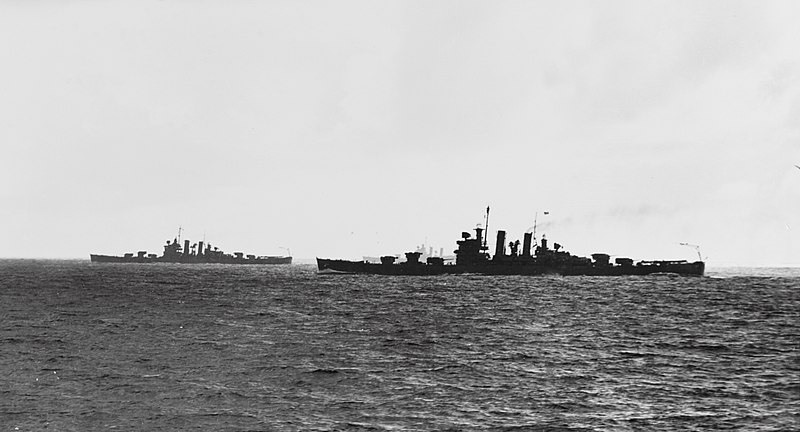
In October 1941, the ST. LOUIS was operating out of Pearl Harbor, attached to Cruiser Division 9, Pacific Fleet.
On Thursday, 16th October, 1941 they steaming in company with USS HELENA in the western half of Hawaiian Operating Area V-16.
At 0730 they went to Air Defense Quarters for firing AA training Practice; catapulted 2 planes to observe the AA firing.
At 0817 they commenced maneuvering on various courses at various speeds
conducting AATP firing run's.
At 0828 they made 3 run's , ceasing at 0912
At 0929 they recovered the target sleeve.
At 0942 AATP firing run #4 was delayed due to towing plane casualty.
At 0950 AATP was postponed.
At 1005 Plane 9SC18 serial number 1141 disintegrated in air and crashed in
Long.157
December 7, 1941 found the ST. LOUIS peacefully moored at the Navy Yard Pearl Harbor, outboard of the USS HONOLULU (CL 48) facing Southeast Loch. Her engines were cold and her crew was carrying out holiday routine. At 0756 two of the ship's officers observed a formation of dark colored, unfamiliar planes approaching from westward over Ford Island. General Quarters was sounded immediately and the crew manned their battle stations on the double.
For a few brief moments those aboard did not realize what was happening, to some it ,just didn't register, to others it was some new type of aerial drill. Those impressions persisted until a torpedo plane roared across her deck, so low that there has no mistaking the rising sun symbol on her wings. Then, to completely dispel any doubt, the plane launched, a torpedo which crashed into the battleship OKLAHOMA moored about 1000 yards off ST. LOUIS's port bow.
The next hour and a half were confused and hectic: The ship's 5 inch battery went into action at once and was credited with three "probable" kills of Japanese planes. This in spite of the fact that the circuit breakers for her guns were ashore for repair and the guns had to be operated manually.
At 0931 ST. LOUIS was underway, due to superhuman efforts of her engine room crew, fortunate to escape, as the enemy planes had largely concentrated their attentions on the big ships moored in nearby "Battleship Row." One of them had dived through ST, LOUIS's fire to make a strafing run along her decks. A few minutes later another dropped a bomb through the dock alongside of which HONOLULU was moored; HONOLULU was damaged and ST. LOUIS was so shaken that those aboard believed she had taken a hit.
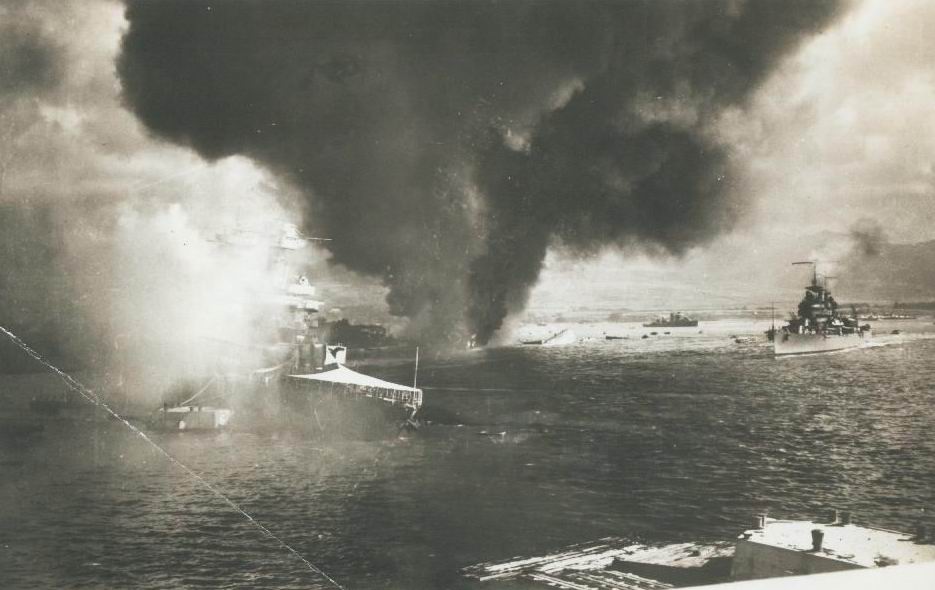
Meanwhile the battleship NEVADA, by heroic action, was underway and proceeding through the narrow channel to open sea. As she approached the narrowest point, between the southern end of Ford Island and Keanapuaa, the Japanese attempted to capitalize on the opportunity of sinking her there and blocking the channel thereby preventing any large units from leaving Pearl Harbor. NEVADA was hit repeatedly as she neared this narrow point, whereupon, realizing the hazard to which she was exposing other ships should she block the channel she beached herself leaving clear egress.
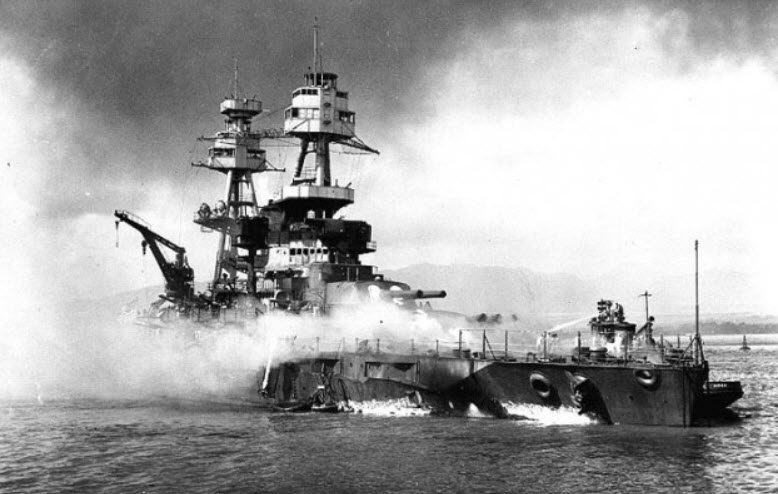
ST. LOUIS steamed by at 25 knots, the first major unit to reach open water. As she stood by the first entrance buoy to the South Channel, a midget submarine fired two torpedoes from 2000 yards on her starboard beam: Both missed, due only to the fact that they grounded on a reef to westward of the dredged channel. Just before the torpedoes were fired, ST. LOUIS obtained a hit with one of her 5-inch guns on the subs conning tower which was later thought to eventually led to the capture of the craft.
The ship then joined a task force of carriers and carried out an unsuccessful search for an enemy carrier reported in the immediate vicinity of the Hawaiian Islands. She returned to Pearl Harbor on 10 December and her crew was brought to wartime strength by addition of now available men from the crew of the stricken NEVADA,
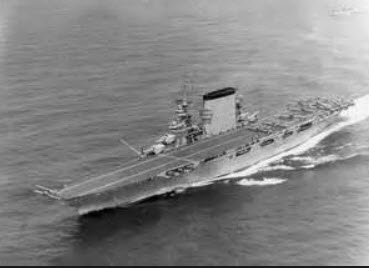
USS Hornet CV-8
At the outbreak of WWII, the St. Louis was 191 men short of its authorized complement. On December 11th, 1941 in Pearl Harbor, 90 seamen were received on board from damaged ships, mostly from the NEVADA. On December 16th, in San Francisco, 101 apprentice seamen were received on board to bring the ship up to complement.
From Dec. 7th, 1941 through the rest of the month, Lucky Lou steamed 8,569 engine miles. By Oct 31st when the Lucky Lou entered Mare Island Navy Yard for repairs, the St. Louis was the U.S. Navy's most traveled ship having made 91,916 engine miles.
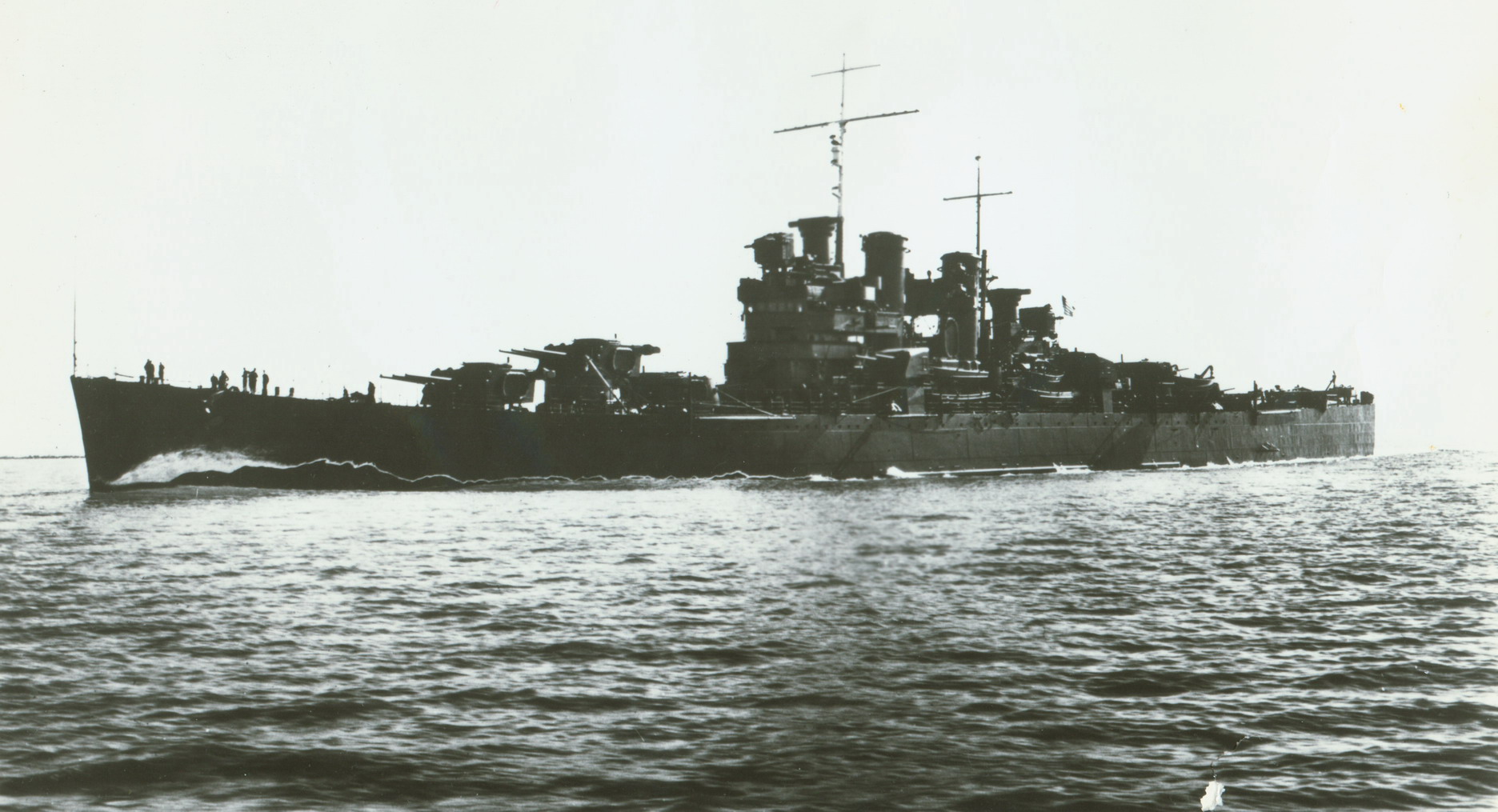
On 1 February 1942; ST. LOUIS participated in the Navy's first offensive action of the war. Compared with present standards the task force that struck the Gilberts and Marshalls would seem almost impotent. Mainly a hit and run raid directed against entrenched Japanese bases. The Task Force, under Admiral William F. Halsey, Jr., was a large one when our resources at the time were considered. It consisted of two carriers, YORKTOWN and ENTERPRISE; heavy cruisers CHESTER., LOUISVILLE, NORTHAMPTON and SALT LAKE CITY, and light cruiser ST. LOUIS and ten destroyers.
Bomb and bombardment damage, some of it very severe, was inflicted on the islands of Wotje, Maloelap, Kwajalein, Roi, Jaluit, Makin, Taroa, Lao, and Gugegwe. Very little resistance was encountered; CHESTER was hit by a bomb and ENTERPRISE suffered slightly from shell fragments. The raid completed ST. LOUIS returned to Pearl Harbor and resumed convoy duty between Hawaii and the United States until May 23, when she delivered two companies of Marine Raiders to Midway; these men were later to land on Makin Island and on Guadalcanal.
On one convoy trip ST. LOUIS rendezvoused with SS PRESIDENT COOLIDGE off Bora Bora in the Society Islands and escorted her to San Francisco in a high-speed run. On board was Manuel Quezon President of the Philippine Commonwealth.
May 25 found the ship underway for the Aleutian Islands where she arrived the 31st and became a part of Task Force 8 in Kodiak. For the next three months she operated to westward, experiencing the thick fogs and heavy weather of the poorly charted area.
In company with the heavy cruisers LOUISVILLE and INDIANAPOLIS plus light cruisers HONOLULU and NASHVILLE, with escorting destroyers she awaited suitable weather for shelling the Japanese base at Kiska and searched for enemy convoys which might be sent in to supply the garrison there.
The bombardment opportunity came on 7 August when the fog lifted for a abort space. A clear view of the target was permitted and the cruisers worked over the beach thoroughly, but the amount of damage was not discernable for the fog closed in again. Late in August, ST, LOUIS assisted in covering the unopposed landing on the Island of Adak, in the Adreanof Group of the Aleutians. This gave us a base closer than Dutch Harbor to the Japanese seized islands to westward.
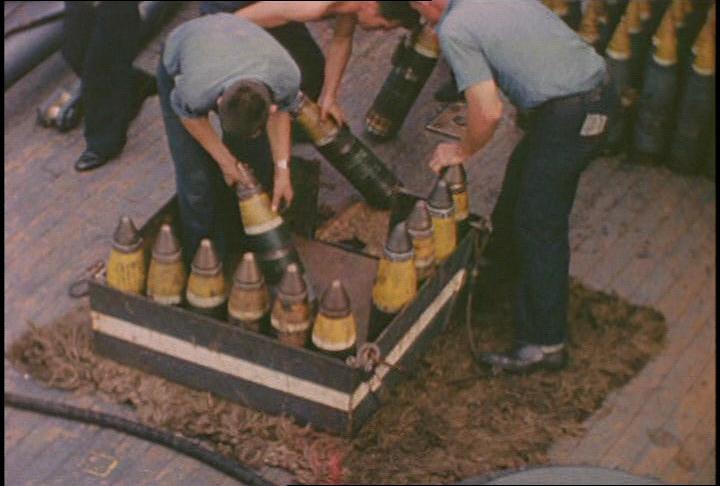
The ship then returned to the Mare Island Navy Yard for overhaul and, on 3 November 1942, experienced her second change of command when Captain Rood was relieved by Captain Colin Campbell, USN.
With the New Year barely underway, ST. LOUIS took part in the bombardment of Munda Airfield, on New Georgia Island of the Solomon Group, with Task Force 67, which consisted of her sister ship HELENA and the light cruiser NASHVILLE.
The bombardment took place the night of 4-5 January, fires were started and a Japanese bomber was shot down. On the night of 23-24 January a similar operation was carried out against the enemy staging base and airfield at Vila-Stanmore Plantation of Kolombangara Island, also of the Solomons, and on 12 May Munda was hit again. These two airfields were threatening our positions on nearby Guadalcanal and were constantly under attack by our land based planes, in addition to the surface bombardments. However, neither the air attacks nor the bombardments were successful in keeping the fields out of commission more than a day or so at a time. For these actions Captain Campbell was awarded the Bronze Star Medal.
Constantly menaced by hostile planes and submarines, ST. LOUIS operated in the now famous and then very dangerous "Slot", the channel through the center of the Solomons, in search of the famed "Tokyo Express", a Japanese task force engaged in almost nightly attempts to reinforce their troop positions. In preparation for our landings at Rice Anchorage, on the north coast of New Georgia Island, ST. LOUIS was among a group of cruisers and destroyers which shelled enemy positions in the Vila-Stanmore and Bairoko Harbor area 5 July 1943, ST. LOUIS stood in through submarine-infested waters and effectively bombarded Japanese shore batteries and installations in the face of intense return fire.
The Tokyo Express was the name given by Allied forces to the
use of Imperial Japanese Navy ships at night to deliver personnel,
supplies,
and equipment to Japanese forces operating in and around New Guinea and the
Solomon Islands during the Pacific campaign of World War II.
The operation
involved loading personnel or supplies aboard fast warships (mainly destroyers),
later submarines, and using the warships' speed
to deliver the personnel or
supplies to the desired location and return to the originating base all within
one night so Allied aircraft could not intercept them by day.
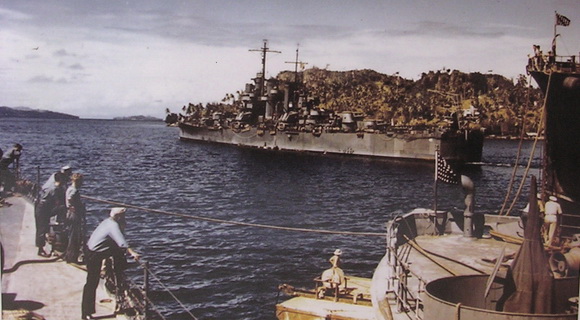
Leaving Tulagi harbor to intercept the "Tokyo Express"
The "Tokyo Express" continued to make successful runs through Blackett Strait and Kula Gulf, between Kolombangara and New Georgia islands, to reinforce their positions at Vila and elsewhere. During the early morning of 6 July contact was made with two enemy groups in Kula Gulf by a United States task force of cruisers and destroyers under Rear Admiral W. L. Ainsworth, USN. Both groups were brought under devastating fire, end although the results could not be accurately observed, two enemy cruisers were considered to have been sunk. Return fire consisted mainly of torpedoes, which sank the sister ship of ST. LOUIS, the light cruiser HELENA.
At one point in the engagements ST. LOUIS's main battery fired continuously for 55 minutes and the total rounds fired amounted to 885. The ship was illuminated by enemy star shells and received not only fire from enemy war ships, but from merchantmen and shore batteries. ST. LOUIS first directed her fire against the same target at which HELENA was firing, then shifted to another leaving both targets riddled and in flames. Later, ST. LOUIS was struck by a torpedo which fortunately failed to detonate.
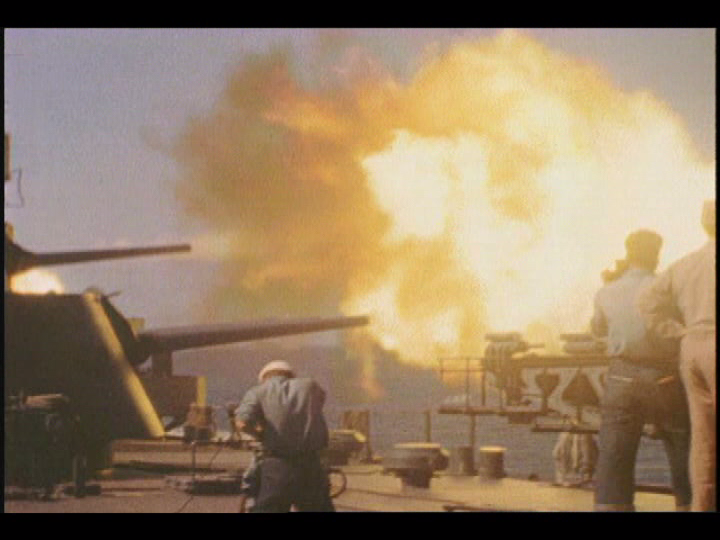
The ship's seeming immunity, capped by this unusual escape, earned her the additional nickname "Lucky Lou". Her participation in the bombardment of the day before and her outstanding performance in the battle earned Captain Campbell the Navy Cross.
Unhindered by her slight battle damage, ST, LOUIS on the night of 13 July took part is the Battle of Kolombangara, or the Second Battle of Kula Gulf, for it was fought in very nearly the same waters as the first battle.
In this action an Australian light cruiser HMS LEANDER , replaced the sunken HELENA. Contact was made with the "Express" on the 12th and the battle followed on the 13th. Again the enemy was disposed in two groups. The first was badly shot up with the light cruiser JINTSU sunk; the second inflicted severe damages on our forces. ST. LOUIS and the light cruiser HONOLULU took torpedo hits as did the LEANDER, and our destroyer GWIN was burning so fiercely that she had to be sunk by our own fire. ST. LOUIS laid her guns on the first ship of the enemy column, then shifted to other targets; at the end of five minutes of firing three enemy ships were afire and practically dead in the water. In this fight ST. LOUIS` main battery expended 1360 rounds of ammunition. Her torpedo damage, although it necessitated a return to the United States for repairs, was accompanied by no personnel casualties. The ship's part in this battle brought Captain Campbell the Silver Star Medal.

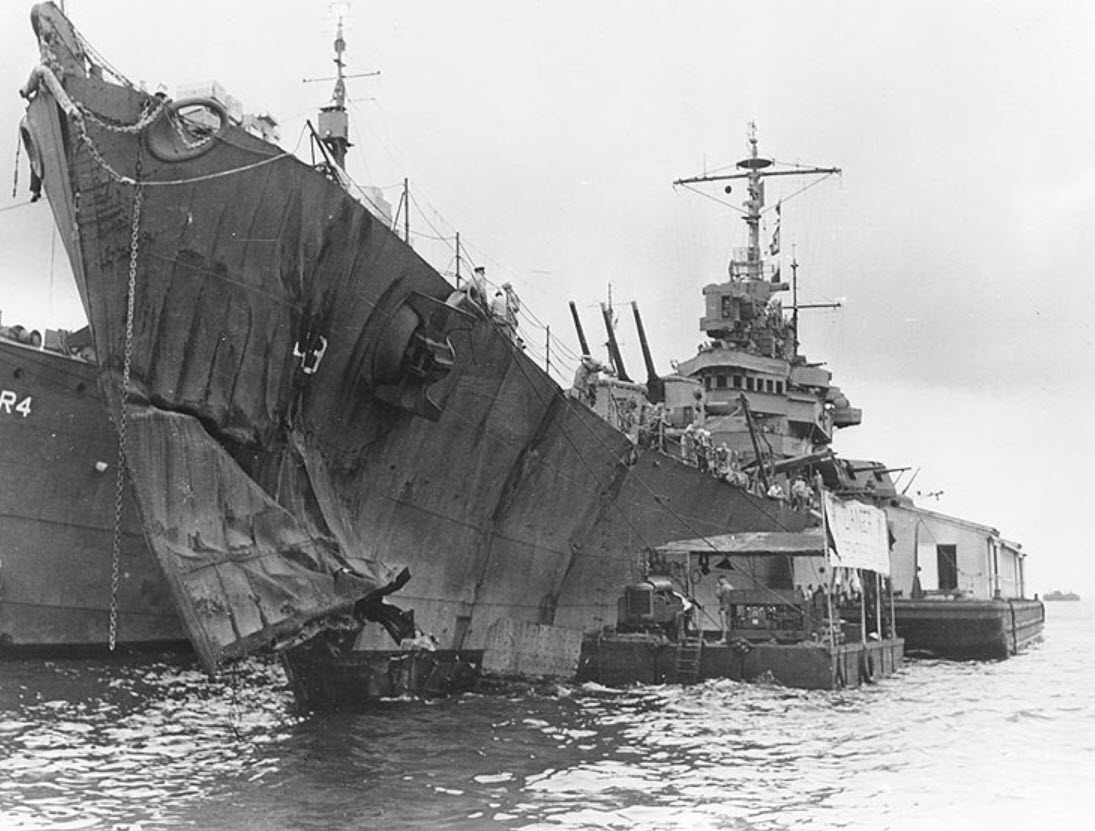
These two engagements were costly, but they prevented certain interference with out landings on northern New Georgia by enemy surface units and denied them the use of the Kula Gulf route for rein-forcing their garrisons at Vila and Munda.
Repairs were effected in the Mare Island Navy Yard and on 12 October 1943 Captain Campbell was relieved by Captain R. H. Roberts) USN.
The ship returned to the battle area in time to assist in covering our landing operations at Torokina Bay on Bougainville Island in December and on 27 December took part in the bombardment of Kieta area. The ship was un-hit by return fire from the beach, but her decks were sprinkled with shell fragments, On 8th January 1944, ST. LOUIS opened counter battery fire against a coastal gun emplacement in the Shortland islands during a similar bombardment and succeeded in silencing it, after which she returned to Torokina to cover the landing of reinforcements there.
ST. LOUIS next operated as a unit of a task force covering our landings on Green Island, north of Bougainville. At sundown of 14 February 1944, six enemy planes, which had been observed circling at a distance, attacked ST. LOUIS in close formation. Two ware driven off by gunfire and the other four split, two carrying out dive-bombing attacks on ST. LOUIS and the other two attacking a nearby destroyer. The first to dive on ST. LOUIS dropped three bombs, all near misses. The second released three more, one of which was a direct hit and penetrated the main deck to explode in the amidships living compartment, killing 23 men and wounding 16. During the short action ST. LOUIS' gone splashed one of the bombers. The after engine room had to be abandoned due to the intense heat, but with fires under control, she made Purvis Bay, on Florida Island in the Solomons, in safety and her crew repaired the battle damage unassisted.
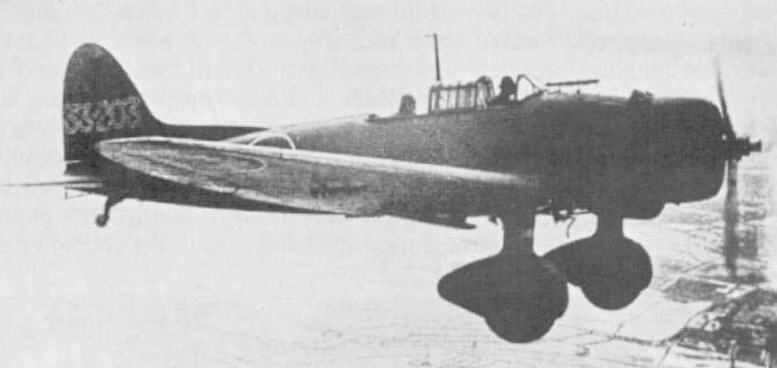
Damage repaired, ST. LOUIS joined Task Force 52 and participated in the bombardment which softened Saipan, Guam, and Tinian for invasion, then assisted in covering the landing operations. This campaign in the Marianas waters lasted from 13 June to 29 July. Saipan was first; then Tinian across a narrow channel, came under fire while minesweepers, working under cover of the surface bombardments, cleared the waters for the assault ships and underwater demolition teams cleared such beach obstructions as could be located.
The Task Force then moved down and smashed installations in the vicinity of the invasion beach on Guam. On 7 July, just before the shelling, ST. LOUIS dropped one of her propellers, probably due to the heavy shocks occasioned by the near misses taken off Green Island. No replacement was available, nor would there have been time to install it, so ST. LOUIS stood in close to the beach, using three screws, and brought to bear all her firepower, even raking the shoreline with her 40-mm AA guns. Captain Roberts later received a letter of commendation from Rear Admiral Ainsworth for ST. LOUIS's effective role in the conquest of the Marianas.
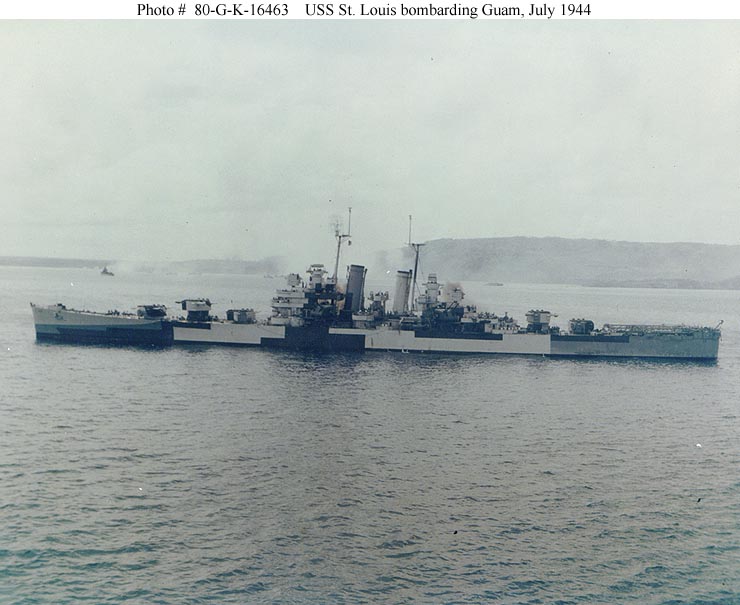
ST. LOUIS returned to Terminal Island, San Pedro, California, for overhaul and carried out extensive training exercises in the area until 9 October 1944, when she departed again for the forward area.
Arriving at Leyte Gulf, in the Philippine Islands on 14 November, the ship joined Task Group 77.2 which consisted of the battleships MARYLAND, CALIFORNIA, and PENNSYLVANIA, the light cruisers DENVER and COLUMBIA, and accompanying destroyers. On 16 November she stood down Surigao Strait to protect our forces which had landed on the Island of Leyte, 20 October.
However the Philippines were not yet secure; enemy planes were based in considerable force on nearby island and enemy resistance was still bitter. During the next two weeks ST. LOUIS experienced no less than 33 air attacks all of which were weathered without damage.
On 27 November the ship was engaged in fueling operations with other ships of the Task Group when a Japanese plane dived undetected from the clouds to drop a bomb in the midst of our ships. The bomb missed, but a moment later ten more planes appeared and made a vigorous and sustained attack. ST. LOUIS's guns were the first to open fire, knocking a determined Kamikaze plane out of control; but it managed to crash against the ship's after starboard side, breaking through into the hanger area.
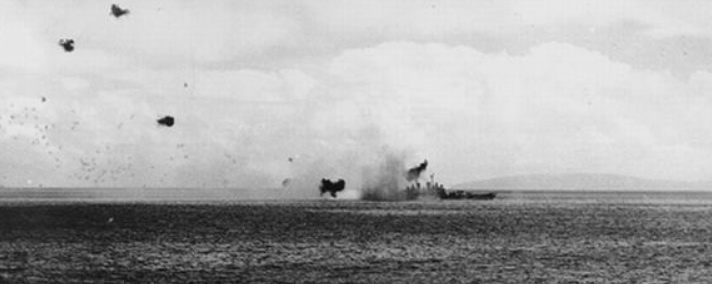
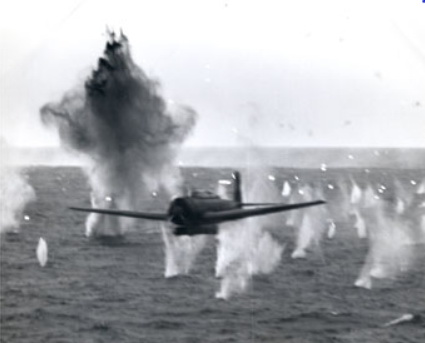
It seemed that the ensuing flames attracted the other planes to ST. LOUIS as five more attacked her immediately as she maneuvered desperately at flank speed. All guns were in action and almost simultaneously a "Judy" was splashed to port with another to starboard to keep it company. A badly riddled "Hamp" just missed the ship, so close that it ripped away hull plating as it plunged into the sea. Another "Hamp" came in low, but was knocked down 2000 yards from the ship. A "Judy", hit by 40-mm fire, crashed off the port quarter and the sky was clear again. Six planes had been shot down in less than 40 minutes, four by the ST. LOUIS alone and two. more with her assistance.

Sixteen men. had been killed at battle stations, several guns were out of action, the hangar cover hung precariously to port, most of the electrical system was out of commission and the ship had a five-degree list but she was afloat with fires under control.
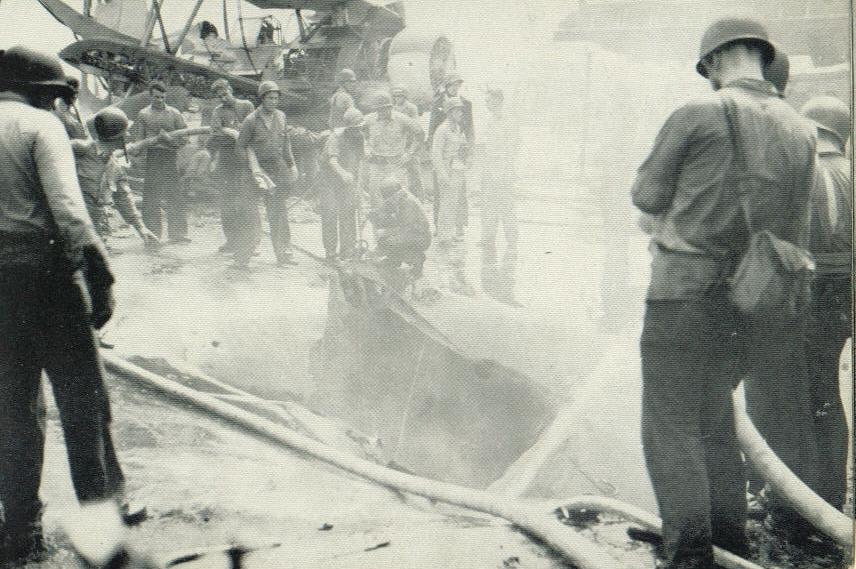
The crippled ship departed the area 29 November, by way of Manus, Admiralty Islands, for San Pedro, California, steaming under her own power. From 26 December 1944 until 22 February 1945, she underwent repairs and yard overhaul. On 3 January 1945, Captain Roberts was relieved by Captain John B. Griggs, USN. At this time Captain Roberts was awarded the Legion of Merit for outstanding services and meritorious conduct while serving as Commanding Officer of ST. LOUIS.
The Japanese homeland was the ships target this time. She joined the famous Task Force 58 in Ulithi Atoll. Caroline Islands, and on 14 March departed for Kyushu, the southernmost island of Japan. This time ST, LOUIS was a support ship for the carriers of the Force which were to launch air strikes. The strikes took place 18-19 March from a launching point 100 miles south of Kyushu. They were directed against airfields on the Islands to eliminate airborne resistance to our landings on Okinawa, to take place 1 April. Fleet units at Kobe sad Kure, ports of southern Honshu were also hit with considerable success. The Task Force, under Vice Admiral Marc A. Mitscher, destroyed 528 enemy planes and damaged 16 surface craft while hangars, warehouses and factories received equal attention.
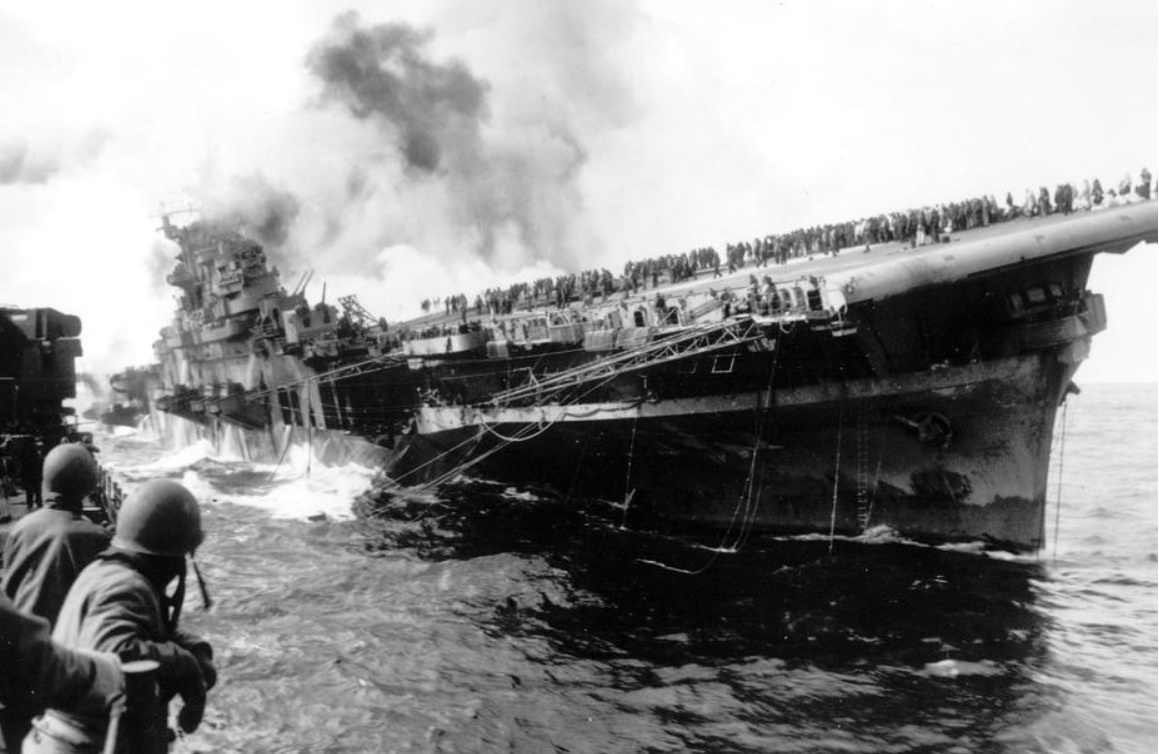
Support ships and carriers came under counter-attack. On the 19th the carrier FRANKLIN received its famous battle damage when hit by two bombs. Dead and missing totaled 774. ST. LOUIS was credited with two assists on attacking Japanese planes.
The ship ST. LOUIS then reported for duty to Task Force 54 which was to commence operations culminating in the assault on Okinawa. The Force consisted of the battleships TENNESSEE, IDAHO NEW MEXICO, ARKANSAS, NEVADA WEST VIRGINIA, COLORADO and NEW YORK, the heavy cruisers SALT LAKE CITY PENSACOLA, WICHITA, PORTLAND SAN FRANCISCO, MINNEAPOLIS , INDIANAPOLIS and the light cruisers BILOXI and BIRMINGHAM.
There followed a period of constant action which consisted of incessant bombardments of Okinawa, both pre-invasion and support, illumination and harassing fire, anti-suicide boat bombardment, call fire, counter shore battery fire and various other duties connected with the support of our operations. On 26 March ST. LOUIS was straddled by two torpedoes from a midget submarine. April 1 (D-Day) her five and six-inch guns blasted a new record in Naval gunfire - 1450 rounds expended.
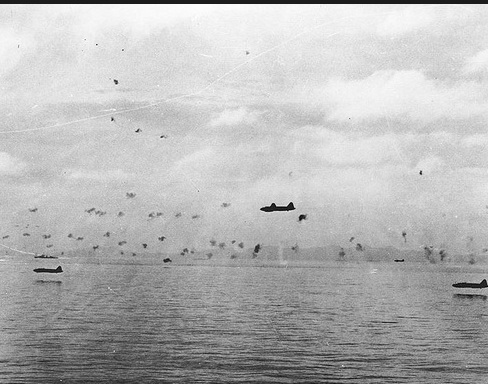
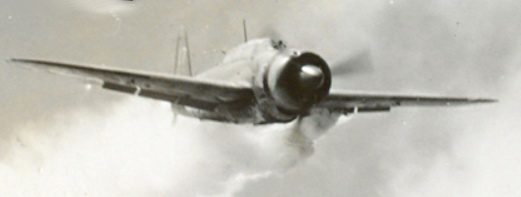
During the period from 26 March through 27 May ST LOUIS fired 26,265 rounds not including 20mm and 40mm AA shells, was taken under fire by shore batteries three times, underwent 88 air alerts participated in 86 shore bombardments and splashed four enemy lanes with four assists. One of the planes was knocked down at a distance of 8000 yards with a 5 inch shell, another at 200 yards with 20's and 40's. The manner in which Captain Griggs handled the ship during this campaign brought him the Silver Star Medal.
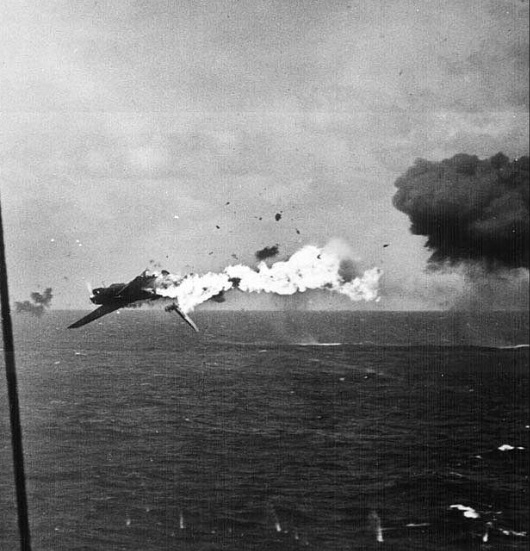
Late in May the ship departed Okinawa for Leyte Gulf and a two-week period of rest and replenishment. She then returned to Okinawa as a unit of Task Force 32 to protect shipping in the area.
Next she joined Task Force 95, reorganization of Task Force 32, and proceeded to the East China Sea where anti-shipping sweeps were conducted and surface and air protection was provided for minesweeping operations. One air strike was conducted by the carriers of the Force against the Chosen-Hangchow area, following which time ST. LOUIS retired to Buckner Bay, Okinawa, for replenishment.
While ST. LOUIS was anchored about 1000 yards from USS PENNSYLVANIA (BB 38) in Buckner Bay) on 12 August a Japanese torpedo plane slipped in and torpedoed PENNSYLVANIA, crippling, but not sinking her.
At the wars end ST. LOUIS sailed for Subic Bay, Luzon, to become part of the SEVENTH Fleet. Captain Griggs became Acting Commander Yangtze Patrol Force and began collecting the various units of his command, most of which were in Philippine waters or the Okinawa area. After one trip to Okinawa, the ship sailed for Shanghai in late September. In October Captain Griggs was designated Commander Task Group 73.12 which was to transport the Chinese 70th Army to Keelung (Taipei), Formosa, Troops were loaded in the Ningpo-China area and landed on Formosa in the middle of October; this was the first Allied force to land there.
October 24 and 25 were spent at Guam where 400 passengers were loaded for transportation back to the United States and discharge. The ship arrived at San Francisco, 9 November, after a short stop at Pearl Harbor, disembarked her passengers and was underway once more for the South Pacific.
This time she touched at Pearl Harbor, the Russell Islands, Guadalcanal, Espiritu Santo and Samoa where she picked up 850 more passengers and landed them at San Pedro, California, 14 December. On 20 December she departed the United States for Guam.
January, 1946 saw the St. Louis, proceed through the Panama Canal, to Philadelphia Navy Yard for operations leading to de-commissioning.
ST. LOUIS was decommissioned on 20 June 1946, in the Philadelphia Navy Yard and later was transferred to the Government of Brazil on 9 January 1951,under terms of the Military Assistance Program. She served the Brazilian Navy under the name of TAMANDARE (C-12).
ST. LOUIS earned eleven Battle Stars on the Asiatic-Pacific Area Service Medal for participating in the following operations:
1 Star/PEARL HARBOR-MIDWAY: 7 Dec 1941
1 Star/PACIFIC RAIDS 1942 Marshall-Gilbert Raids 1 Feb 1942
1 Star/CAPTURE AND DEFENSE Of GUADALCANAL: 10 August 1942 to 8 Feb 1943
1 Star/CONSOLIDATION OF SOLOMON ISLANDS:
Consolidation of Southern Solomon Islands
8 Feb 1943 to 20 Jun 1943
Consolidation of Northern Solomon Islands
27 Oct 1943 to 15 Mar 1945
1 Star/NEW GEORGIA GROUP OPERATION
New Georgia-Rendova-Vangunu Occupation 20 Jun
1943 to 31 Aug 1943
Kula Gulf Action 5,6 Jul 1943
Kolombangara Action 12,13 Jul 1943
1 Star/TREASURY-BOUGAINVILLE OPERATION:
Occupation and Defense of Cape Torokina 1 Nov
1943 to 15 Dec 1943
1 Star/BISMARCK ARCHIPELAGO OPERATION:
Green Islands Landing - 15 to 19 Feb 1944
1 Star/:MARIANAS OPERATION:
Capture and Occupation of Saipan 11 June
1944 to 10 Aug 1944
Capture and Occupation of Guam 12 July
1944 to 15 Aug 1944
1 Star/LEYTE OPERATIONS: Leyte Landings 10 Oct 1944 to 29 Nov 1944
1 Star/OKINAWA GUNTO OPERATION:
FIFTH/THIRD Fleet Raids in support of Okinawa Gunto Operation 17 Mar
1945 to 11
Jun 1945
1 Star/THIRD FLEET OPERATIONS AGAINST JAPAN: 10 Jul 1945 to 15 Aug 1945